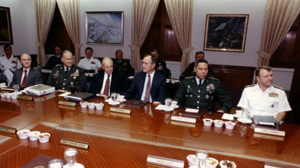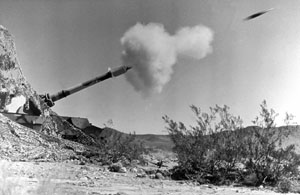Twenty years ago this fall, President George H. W. Bush announced sweeping changes to the US nuclear force structure.
In a speech to the nation on Sept. 27, 1991, Bush said he ordered the destruction of all American ground-based tactical nuclear weapons. Sea-based tactical nukes would be withdrawn from deployment as well.
All Air Force strategic bombers and 450 Minuteman II missiles were taken off alert status. Mobile US ICBM programs were halted—as was the AGM-131 nuclear short-range attack missile.
Bush made these moves unilaterally, with a few strokes of his pen. He indicated the US would carry them out regardless of Soviet reaction. But he invited Soviet President Mikhail S. Gorbachev to take similar actions. “If we and the Soviet leaders take the right steps—some on our own, some on their own, some together—we can dramatically shrink the arsenal of the world’s nuclear weapons,” said Bush in his address.
Days later, Gorbachev responded with his own reductions. He said the USSR would match the US on removal and dismantlement of tactical nuclear weapons, while taking 500 missiles off alert and canceling some strategic modernization programs. After the Soviet Union collapsed at the end of 1991, new Russian President Boris Yeltsin vowed to live up to Gorbachev’s nuclear commitments, and even to expand upon them. He said Russia would end further development of nuclear sea-launched cruise missiles, for example, and destroy its existing SLCM stocks.
 |
Members of a SAC alert crew race for their B-52 during a base alert exercise in the Cold War. (DOD photo) |
Taken together, all these moves did not usher in a nuclear nirvana. The US and the successor states to the USSR still had thousands of strategic weapons both deployed and in reserve. Nor did Bush’s reductions push the teetering Soviet Union over the edge. It was unraveling anyway due to the pressure of larger geopolitical and economic forces.
Racing Downhill
But Bush’s Presidential Nuclear Initiatives (PNIs) still mark an extraordinary moment in history, the point at which it might be said that the US truly won the Cold War. For decades, the superpowers had been piling warhead upon warhead. As historian Raymond L. Garthoff has noted, Bush’s September speech and Gorbachev’s response were a time when the arms race ran in reverse—downhill. Furthermore, the PNIs showed that ponderous negotiations aiming at a treaty were not the only way to cut nuclear arsenals. Unilateral arms control turned out not to be an oxymoron. And it was perhaps a good example of the deftness with which Bush handled the US response to the USSR’s collapse and Russia’s rebirth as a separate state.
“George H. W. Bush … presided with great skill over the [Soviet] transition,” wrote former Air Force nuclear negotiations expert Michael O. Wheeler in a 2004 report co-authored for the USAF Institute for National Security Studies.
When Bush assumed office as the 41st President in 1989, the nation’s nuclear policy was still focused on traditional deterrence, meaning the prevention of war and nuclear use by a superpower adversary. “Arms control” meant the Strategic Arms Reduction Talks, which the US and the USSR had engaged in, off and on, since 1982.
The talks hit another hiatus at the beginning of the Bush presidency, as the new Administration paused for a review of where arms control strategy was going. Afterward, the Strategic Arms Reduction Treaty was wrapped up fairly quickly, by the standards of bilateral nuclear efforts. The US and the USSR signed what became known as START I on July 31, 1991. The treaty cut the number of Soviet deployable nuclear warheads by approximately one-third from its highest levels just before the end of the Cold War, to 6,000 warheads on 1,600 strategic offensive delivery vehicles.
 |
|
Against this background, several other issues were contributing to the development of what would become the PNIs. One was that some top officials in the Bush team were dismissive of tactical nuclear weapons. National Security Advisor Brent Scowcroft had argued for a ban on ship-launched cruise missiles since the middle of the 1980s, for instance.
Chairman of the Joint Chiefs of Staff Gen. Colin L. Powell thought that maintaining nuclear artillery shells was a waste of money, though the Army and Secretary of Defense Richard B. Cheney opposed his efforts to get rid of them. “I was becoming more and more convinced that tactical nuclear weapons had no place on a battlefield,” writes Powell of that period in his memoir, My American Journey.
The threat these weapons were designed for—a Soviet invasion of Western Europe—had diminished considerably since the dissolution of the Warsaw Pact began in 1989. Soviet forces were pulled back to the east, beyond the range of land-based American tactical nuclear delivery systems. The USSR had deployed thousands of these weapons itself, of course. Many were still stored at bases in remote corners of the crumbling Soviet empire. In the fast-changing political environment of the early 1990s, the biggest threat posed by these weapons was not their possible use in war, but the chance that they might go missing and end up in the hands of rogue dictators or terrorists.
A shock pushed Bush and his advisors into action.
 |
B-2 bombers on the production line. President Bush’s nuclear initiatives essentially ended B-2 production. |
Soviet hard-liners mounted an unsuccessful coup against Gorbachev in a last-ditch effort to maintain the empire stitched together by Lenin and Stalin. During the initial phase of the coup, the US was not sure who controlled the Soviet nuclear arsenal: Gorbachev, coup leaders, or the Soviet General Staff. “The abortive coup in Moscow in August 1991 … caused alarms about the strength of central control over nuclear weapons inside the Soviet Union,” wrote Congressional Research Service nuclear expert Amy F. Woolf in a February 2011 report on nonstrategic nuclear weapons.
While still on summer vacation at his Kennebunkport, Maine, compound, Bush ordered aides to begin drawing up a new disarmament proposal. By nature, Bush was a methodical chief executive, a “wouldn’t be prudent” President, in comedian Dana Carvey’s famous parody. But this was a time to move quickly. Negotiating a treaty would take too long. What mix of unilateral US moves might lure Gorbachev into reciprocal action
The answer was the PNIs.
Though many of the ideas included in Bush’s initiatives previously were the subject of interagency discussion, the final package was pulled together in about three weeks. “The US initiative was not contingent on a Soviet response, and the Bush Administration did not consult with Soviet leadership prior to its public announcement, but many hoped that the US initiative would provide President Gorbachev with the incentive to take similar steps to withdraw and eliminate many of his nation’s nonstrategic nuclear weapons,” writes Woolf.
End of a 35-Year Era
As analysts noted at the time, in a broad sense Bush’s initiative was an attempt to bring arms control into a new era. The central nuclear threat to the US was rapidly becoming “loose nukes,” as opposed to war. The need to deter the USSR was being replaced by the need to dissuade a Soviet successor state from continuing the arms race, as an attempt at political gain.
In an immediate, practical sense the PNIs were designed as an offer Gorbachev would find difficult to refuse. They were an opportunity for the last leader of the USSR and the new leader of the Russian Federation, Boris Yeltsin, to do something in the best interests of their citizens: Lower tensions while cutting back on military spending.
Gorbachev’s reply came on Oct. 5, 1991. The Soviet Union would destroy all nuclear artillery ammunition and warheads for tactical missiles, remove warheads for nuclear anti-aircraft missiles and destroy some, destroy all nuclear land mines, and remove all naval tactical nukes from subs and surface ships. On strategic weapons, Gorbachev’s moves included a pledge to stop building new mobile launchers for ICBMs, and to stop deploying existing rail-mobile missiles.
As was the case with Bush, the Soviet leader likely was offering up many things Soviet officials had discussed for some time. By USSR standards, however, the reply still came at lightning speed. “It is possible that President Gorbachev compiled his list of measures in the 10 days between the speech by President Bush and his response,” wrote Woolf in a 2001 CRS study of unilateral versus bilateral approaches to arms control.
 |
|
Gorbachev had other weighty matters on his mind at the time. Following the failed coup, the USSR hurtled toward dissolution. Throughout the fall, the Soviet Union became increasingly hollow as individual republics declared their independence. In the early evening of Dec. 25, Gorbachev resigned his office, declared it extinct, and passed on all his remaining powers to Russian leader Yeltsin.
Still, the reverse arms race continued. A few weeks later, Yeltsin asserted Russia’s status as the Soviet Union’s legal successor in terms of international agreements. He pledged Russian policy would be to eliminate nuclear weapons “gradually on a parity basis,” and said he would continue and expand Gorbachev’s recent reduction pledges.
On Jan. 28, 1992, President Bush weighed in with an addendum to his previous initiatives. In his State of the Union address Bush noted that for the first time in 35 years US bombers were not on a round-the-clock alert to respond to a possible nuclear attack. He added that the US would shut down production of the B-2 bomber following the purchase of 20 aircraft, would cease production of new warheads for sea-based Trident missiles, and end production of advanced cruise missiles, among other unilateral moves. Bush also offered to agree with Russia to ban multiple-warhead land-based missiles—a proposal which would lie at the heart of the START II arms accord he and Yeltsin would sign a year later. “The biggest thing that has happened in the world in my life, in our lives, is this: By the grace of God, America won the Cold War,” said Bush.
The pledges stemming from the Presidential Nuclear Initiatives were just that—pledges. They did not have the time frames or verification procedures that generally accompany bilateral agreements. Still, the US implemented them fairly quickly.
It took only a few days or weeks to remove bombers and ICBMs from alert status, as promised. Nonstrategic nuclear weapons were removed from bases in South Korea by the end of 1991, and from bases in Europe by mid-1992. The Navy withdrew their corresponding weapons from ships, submarines, and forward bases by mid-1992. The actual dismantlement of warheads took much of the 1990s to complete for some weapons. This was due to the limited capacity of the Pantex plant in Texas, the only US site where the process occurs.
As for Soviet and Russian action, most nonstrategic nuclear weapons appear to have been withdrawn from Eastern Europe and the Transcaucasus prior to Gorbachev’s 1991 announcement. They were out of Ukraine and Belarus by spring 1992. Their status on Russian territory itself is less certain. By some reports, some systems were not withdrawn until 1996 or 1997. “It appears Russia was not as quick as the United States to remove TNWs [theater nuclear weapons] from deployment,” wrote nuclear expert Joshua Handler in a report on TNW disposition prepared for a 2001 UN conference.
In terms of destruction of the weapons, Russia provided far less information than the United States. Russian officials at the Nuclear Nonproliferation Treaty review conference in 2000 pledged that the dismantlement process would be finished that year, but there has been no confirmation this occurred. “Some analysts and experts in the United States have expressed concerns about the slow pace of eliminations in Russia,” wrote CRS’ Woolf in her 2011 report on nonstrategic nukes. “They note that the continuing existence of these warheads, along with the increasing reliance on nuclear weapons in Russia’s national security strategy, indicate that Russia may reverse its pledges and reintroduce nonstrategic nuclear weapons into its deployed forces.”
 |
|
Trust, Don’t Verify
It is also possible Russia simply does not have the money to spare to finish this effort or may be waiting to coordinate it with retirements of older strategic weapons. Uncertainty as to Russian compliance with its 1991 pledges points out one of the weaknesses of unilateral arms cuts—they’re difficult to monitor. Since they are not binding in terms of international law, there is also always a possibility for a destabilizing reversal of course.
However, given that nations are unlikely to pursue such reductions except in the context of relatively good relations, these flaws may not matter much. So far, this appears to be the case with the PNI-inspired process. Russia and the US still have some profound geopolitical differences, but there is little indication any new Cold War is on the horizon.
Meanwhile, Bush’s bold stroke demonstrates one of the strengths of such an approach: They can allow for sweeping change in a short period of time. The traditional bilateral START took nearly a decade to complete, from proposal to signing. Bush’s PNI went from a theory to reality in less than a month.
The success of the PNIs can be seen in the fact that their architect’s son, President George W. Bush, modeled his own approach to strategic arms on them.
The George W. Bush Administration proposed the US and Russia reduce their long-range nuclear warheads to between 1,700 and 2,200 apiece without dependence on a formal treaty. At Russian insistence, the US eventually agreed to put this arrangement on paper. In 2002, Bush and Russian President Vladimir Putin signed the Treaty of Moscow, a short, flexible document that codified the reduction pledge, but contained no verification provisions.
It was superseded by the New START pact, a more traditional treaty, which took effect in February 2011.